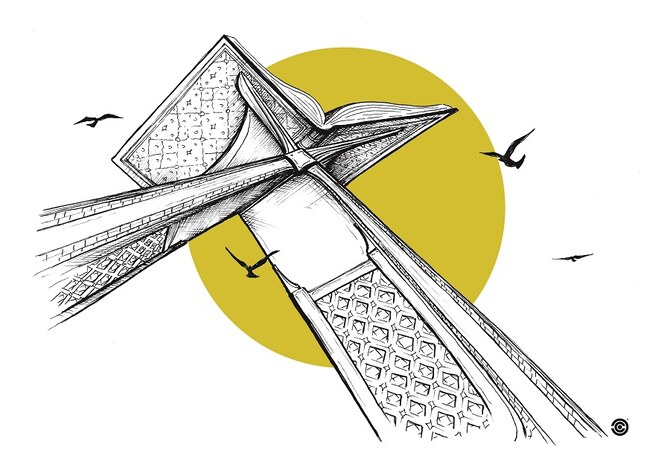JEDDAH: Rana Alsaggaf has carved her own space in the Saudi art scene with her intricate sketches of landmarks from across the Kingdom. With a background in interior design and master’s degrees in entrepreneurship and innovation as well as international art and culture management, her practice is deeply rooted in both technical knowledge and a passion for heritage.

Rana Alsaggaf. (Supplied)
Recently, she had the honor of showcasing her work at the second Islamic Art Biennale in Jeddah, an experience she describes as both meaningful and humbling.
“It’s an opportunity to present my work in a space that celebrates the intersection of faith, culture, and artistic expression,” she told Arab News.
Alsaggaf is showcasing “Sacred Journeys” at the biennale, which runs until May 25. It is a collection of works that visually narrate the journey from Jeddah to Makkah, a path traveled by millions of pilgrims. It was installed at the Jeddah Airport Pilgrims Gateway, a setting that naturally resonated with the work.

'Bab Al-Salam Gate.' (Supplied)
“This route is more than just a road, it is a transition into a sacred experience,” Alsaggaf explained. “By sketching its key landmarks, I wanted to highlight the gateways that pilgrims pass through on their way to Makkah. I hope my work inspires people to explore these places and to connect with their history in a way that feels tangible and relevant today.”
Alsaggaf’s artistic process always begins with firsthand exploration. She visits the sites, sketches on location whenever possible, and refines her compositions by focusing on perspective, architectural details, and the emotions these places evoke. Research also plays a key role in her work; she digs into the history of each landmark, uncovering stories that add depth to the experience.
To enhance this connection, with each artwork she includes a card sharing insights about the location. By keeping her color palette minimal, she ensures the focus remains on the form, history, and character of each landmark.

'Historic city wall of Jeddah' by Rana Alsaggaf. (Supplied)
Alsaggaf chose to highlight the pilgrimage gates because of their historical and functional significance, as well as their strong connection to the Islamic Art Biennale’s location.
“These gates mark important entry points for travelers and pilgrims, making them both symbolic and relevant. Each one represents a threshold, a moment of arrival and transition on the journey to Makkah,” she said.
Through her art, Alsaggaf hopes to spark curiosity and inspire people to visit these sites, experiencing their significance firsthand. “I want my sketches to create a sense of connection,” she stated. To enhance this connection, she draws from an eye-level perspective, making viewers feel as though they are standing right in front of the landmarks. Her illustrations act as a bridge between the past and present, preserving the spiritual and cultural heritage of the Hajj.
“These places are not just remnants of the past; they continue to welcome travelers and pilgrims every day. Through my art, I want to ensure they remain part of our cultural dialogue,” Alsaggaf said.
While her work is rooted in direct observation, Alsaggaf takes care to research each site’s historical context. However, rather than reconstructing what no longer exists, she prefers to depict landmarks as they stand today, emphasizing their continued presence and relevance.
“The biggest challenge is capturing the depth of the experience in a way that feels immediate and real. I wanted my sketches to reflect the emotional weight of the journey while staying true to the landmarks’ current state,” she explained. “Balancing simplicity with meaning was key.”
Jeddah’s Rawasheen, the intricately carved wooden balconies found on historic buildings, have been a recurring theme in Alsaggaf’s work. Beyond their striking appearance, they represent the layered history of Jeddah as a gateway for travelers and pilgrims.
“For me, they are windows into the soul of the city, reflecting both its past and its living heritage,” she said.
These ornate facades are a symbol of craftsmanship, cultural exchange, and architectural identity — elements that Alsaggaf is passionate about preserving through her sketches.

'The Pilgrim's Gateway' by Rana Alsaggaf. (Supplied)
Alsaggaf uses her Instagram page, Wings Over Saudi, to share her art — which includes paintings as well as sketches — with a wider audience. The name was inspired by a legendary Jeddah folktale involving seagulls, and reflects her artistic vision of movement, exploration, and perspective.
“It represents the way I approach my art, not just as static images, but as invitations to discover Saudi’s landscapes, cities, and cultural landmarks,” she explained.
Her collection of paintings titled “Reflections of Jeddah” is a tribute to the coastal city’s historic streets. Created in her studio within Jeddah’s heritage district, the series captures the play of light, shadow, and intricate designs that define its acclaimed architecture.
“Through these works, I aim to preserve Jeddah’s historic charm while celebrating its enduring cultural significance,” she said.
Another series, “Sketchbook Journey,” highlights the wider Kingdom’s diverse architecture, from grand mosques to ancient alleyways.
“Each piece in this series honors Saudi Arabia’s architectural legacy, preserving its beauty for future generations while encouraging a deeper appreciation for the artistry and heritage that define the Kingdom,” she said.
Alsaggaf sees endless opportunities to continue exploring and documenting her homeland.
“There are so many incredible landmarks still to capture,” she said. “I want to keep sketching, discovering, and sharing the beauty of these places with others.”














